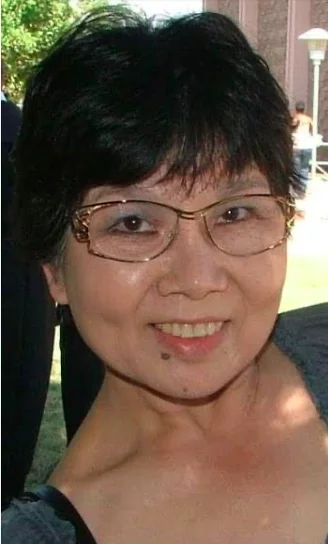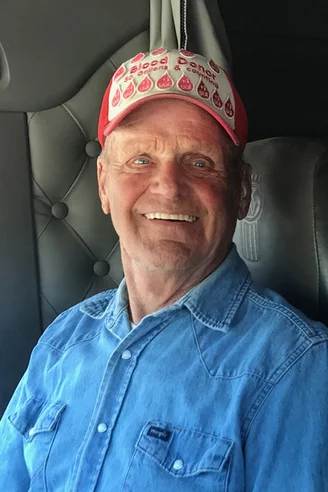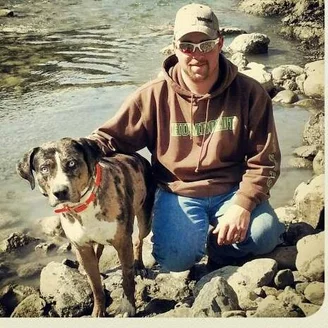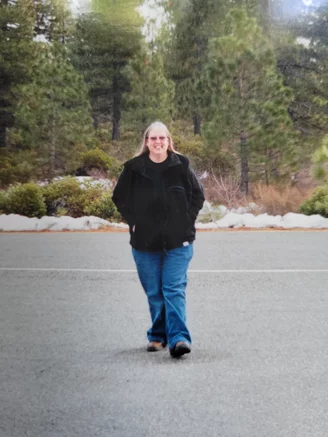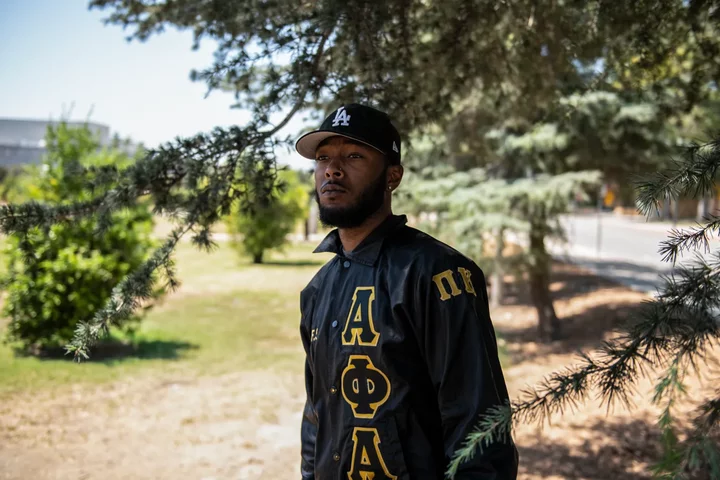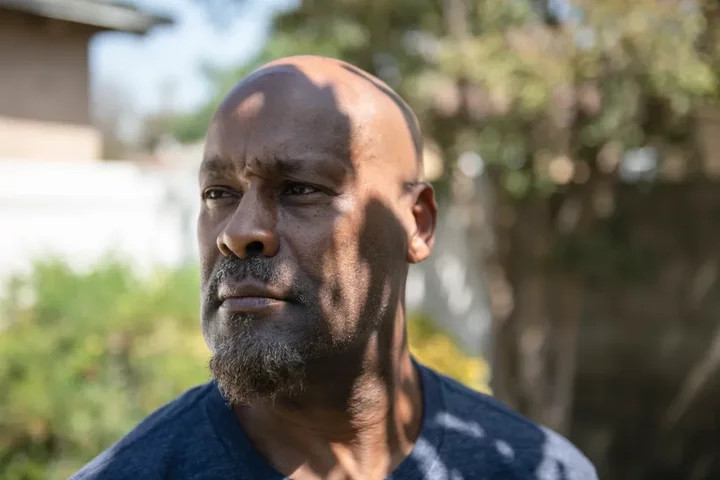OBITUARY: Pi Lien ‘Amy’ Sedam, 1946-2022
LoCO Staff / Tuesday, Aug. 23, 2022 @ 6:56 a.m. / Obits
Pi
Lien “Amy” Sedam passed away on the morning of August 19, 2022 in
the home of her daughter and son-in-law. Amy was born on July 20,
1946, in Tainan, Taiwan. She married Wayne Sedam, who was in the Navy
and stationed in Taiwan, in 1971. Shortly thereafter, they came to
the United States. Amy, Wayne, and their two children moved to
Humboldt County in 1980, as Wayne was stationed at Centerville Beach
in Ferndale.
In 1985, Amy opened her restaurant, Amy’s Delight, on Harris Street in Eureka. In 1997, she moved a few blocks down on Harris Street into a bigger restaurant, remodeled it and served Eureka at that location until the spring of 2020.
Amy loved her restaurant and loved her customers. She would often say, “My customers are the very best people.” Amy cooked Chinese food, burgers, and breakfast, and her partner, Darrell Siggins, who preceded her in death in October of 2021, waited tables. In her 35 years of owning Amy’s Delight, she always looked forward to seeing her customers who became friends. After closing her shop, Amy opened Amy’s Liquor and Market in the same building, and she worked there until it sold in January of this year.
Amy was known for her kindness and generosity, and she loved to help people. Amy loved Eureka, and everywhere she went, people recognized her and talked to her. She brought light and a beautiful smile to all she met. She was dearly loved by many.
Amy is survived by her daughter, Lisa Van Horn, son-in-law Brian Van Horn, and grandkids Ryley and Kirah Van Horn of Woodland. She is survived by her son, Mike Sedam, daughter-in-law Cory Sedam, and grandson Ryder Sedam of Roseville. She is survived by her sister, Susie Adams, her nephews Tom, Steve, and John Adams, and their families from Lemoore, Calif. She is survived by many friends, families and loyal customers.
Please stop by to celebrate her life anytime between 12 p.m.-2 p.m. on Sunday, September 11 at Amy’s former restaurant, now Island Delight, 401 W. Harris St., Eureka, CA. If you have any pictures of Amy or Darrell, please email them to: amysdelight3@gmail.com. They will be featured in a slide show at the celebration of life event.
###
The obituary above was submitted by Amy Sedam’s loved ones. The Lost Coast Outpost runs obituaries of Humboldt County residents at no charge. See guidelines here. Email news@lostcoastoutpost.com.
BOOKED
Yesterday: 5 felonies, 2 misdemeanors, 0 infractions
JUDGED
Humboldt County Superior Court Calendar: Today
CHP REPORTS
No current incidents
ELSEWHERE
County of Humboldt Meetings: McKinleyville Municipal Advisory Committee Meeting
Governor’s Office: Governor Newsom Announces Appointments 4.19.24
Wild Rivers Outpost: Annual Economic Summit Focuses On Transportation, Health Care
Wild Rivers Outpost: Hoping To Generate Revenue, Curry Commissioners Create Forestry Department
OBITUARY: George Jerome Niles, 1937-2022
LoCO Staff / Tuesday, Aug. 23, 2022 @ 6:56 a.m. / Obits
Our dad, George Niles, age 84, passed away in a tragic accident on the evening of June 20, 2022. We are all very saddened and hope to share a bit about our dad.
George was born in 1937 in Wellsboro, Pennsylvania. He grew up on a small dairy farm and attended school at Charleston Elementary / High School were he played basketball and wrestled. He worked at his Uncle Leon’s lumber mill, LG Niles Lumber Mill, during high school and on the farm in the summer. When he graduated from high school, he wanted to attend bible college and become a pastor. He attended Practical Bible Training School in Johnson City, NY. His second year of college dad had to sell his beautiful ’55 Chevy to pay for school tuition. He always wished he still had that ’55 Chevy. He loved that car! He wasn’t just a student, he also enlisted in the National Guard. During his time at college, he was diagnosed with a brain tumor and had to quit college for a bit for emergency surgery. During his recovery he attend church at Fatih Baptist where he met his wife, Wanda. They married in 1963 and had four children: Mary, Mark, Carol, and Daniel.
After bible college, George became the pastor of two small churches; first in Antrim, Penn. and later in Stonyfork, Penn. He didn’t make a lot of money at the churches, so he also drove semi-trucks hauling coal from the coal mines, and both he and Wanda drove school bus. One winter with wind chill factor of -40 degrees, he told his fellow workers, “This will be my last winter here boys!”, (As he would tell the story….); his co-workers would say, “Oh George you won’t leave, you like the BIG money.” ($3.75/hour back then, if we remember correctly). George and Wanda has friends in Benson, Ariz. that summer he packed us up and headed for Benson.
We lived in Benson for four years where George worked for the local electric company. He always worked hard and provided for his family. George and Wanda divorced after 18 years of marriage. When Wanda remarried, she, her husband, and kids moved to Eureka. George relocated to Tucson, Arizona where he met his second wife, Marie. Marie and George loved the desert, crazy heat at all! He drove cement truck, hauled hazardous waste, iron ore, and even tried long hauling mail. Marie unfortunately passed away years later from multiple strokes. After being alone in Tucson for awhile, he decided to move closer to his kids and grandkids. He loved spending time with family.
George was always so proud of his kids and introduced them to everyone. He’d say, “Hey this is ….” and proceed to introduce whichever child was with him to his friends. He talked about family all the time. A family friend, Jan, that we introduced to him ended up being his third wife. They lived in Cutten and had horses, which was also a passion of George’s. After a few years, they divorced, and George moved to Fortuna to Royal Crest Mobile Home Park, but he continued to help her as she failed in her health, eventually passing away. Dad lived many years at Royal Crest, meeting many friends, like Paul. Paul, THANK YOU for watching out for him and sharing so many yummy meals. Dad always loved your cooking!
George recently moved to an apartment at Mountain View, Lutheran Home of the Aging in Fortuna, where he currently lived. He loved his little apartment and made friends with many of his lovely neighbors. Thank you, Ida, for looking out for dad and keeping us “informed”. You truly cared about his safety, and his family appreciates that. Thank you Stacey and Mike for being so good to him.
Dad was a pastor for the Wiyot Tribe in Loleta for a few years prior to Covid. He enjoyed going and seeing the children who always looked for the cookies dad would bring them. He would always tell us how cute they all were with a huge smile on his face. He loved and respected the Native American people so much. If he saw someone with long dark hair, Dad would always say, “I think their hair is so pretty!” He consistently gave donations to organizations helping the Native American tribes throughout the country.
He also supported his long time best friend, Cal Sears, who was a missionary in Mexico. He told stories of Cal and his family a 100 times if not more. He cherished Cal’s friendship so much. Cal passed away a few months before dad. We’re sure they’re together in Heaven telling stories of the good ole days.
His love for God, and his family was so prevalent. His apartment was filled with photos of his kids and grandkids, and his Bible was always open on the table. Sermon notes were always being studied and sides notes can be found all throughout his Bible. He was a good example of God’s love to his children and others. He accepted people for who they were and would do his best to help anyone who had a need.
One of George’s proudest accomplishments was being the second highest blood / platelet donor in Humboldt County, 42 gallons! He had a standing appointment every two weeks to give blood, and he was faithful. He loved chatting with the ladies at the Blood Mobile and The Blood Bank. Dad had to give up donating blood due to a medication he was taking. He asked all the time, ‘When can I stop taking this medicine so I can start giving platelets again?” Every time we were in Eureka, he’d say, “Do we have time to stop at the Blood Bank and say hello? It’ll just take me a second.” He’d come out with a cookie or piece of candy and a cup of coffee. Thank you to everyone who was so kind to him when he visited. Michelle and Dee (along with others we don’t know), you meant a lot to him. We hope to carry on his legacy by donating in his honor.
Dad was our biggest fan! Dad always supported our sports, and attended every game he could. He’d always ask, “When’s the next game!” He loved watching his kids and grandkids, whether it be basketball, baseball, soccer, volleyball, football, wrestling, or cross country. One of George’s staple comments after a game, holiday get together, or special event was, “Well I think everyone had a good time!”
Dad was always so positive and happy. He loved genuinely and unconditionally. Dad will be missed here on the streets of Fortuna. Many people have grown to love dad’s gentle smile, and his friendly wave. And a few people even got the pleasure to know him by hearing his “stories”. Dad could tell stories “loudly” from a long time ago and he told them hundreds of times as if he’d not told them before. We’re going to miss them. It’s a shame we didn’t think to record more of them.
Dad was a walking legend around Fortuna. He knew no strangers. His daily morning walk was to Burger King for “pancakes, sausage & coffee with 1 ice cube, and a splash of milk”, then back for lunch for his favorite, a “cheeseburger no onions, and a diet pop”. He LOVED his cheeseburgers! George was loved and watched over by the staff. Anna and Crystal you are angels! Anna and Crystal were like daughters to him. They tried to keep him from being taken advantage of by people on the street, who were always asking for money. George has a heart for people less fortunate and he daily bought multiple meals for them. They would always call us if they were worried about him. Thank you to the whole crew at Burger King.
His walks were slowing down in speed but he was consistent. Driving down the boulevard won’t be the same without George. The town came to love him, as we have learned from all the sweet stories we’ve been told.
Dad is preceded in death by his parents Jerome & Myrtie Niles, brother Lewis Niles, sister Phyllis Hazelton (Jim), second wife Marie Niles of Tucson, third wife Jan Niles of Eureka.
He is survived by his sister Francis Dewey, his sister-in-law Joann Niles, first wife Wanda Hoffman (LeRoy), his four children and their families: Mary Stewart (Chip), Mark Niles (Cheryl), Carol Wood (Hec),and Danny Niles (Teresa).
George adored his grandchildren : Kendall, Jacob, Ashley (John), Amber (Christian), Brittany (Micheal), Kara (Tyler), Topanga, Brooklyn, Eli, and Readan, and great grandkids Trenton, Analiese, Brielle and Rowan.
Thank You to the Fortuna Fire, City Ambulance, and the Fortuna Police Department, for being at his aid so fast and Redwood Memorial Hospital for trying your best to help our dad. Your jobs are not easy, and we appreciate the line of work you’ve chosen to help others.
In lieu of flowers , our family has found two ways to give back in his honor. Giving the GIFT OF LIFE through donating blood (which was one of dads proudest accomplishments) or monetarily to the Northcoast Community Blood Bank in Eureka or the charity of your choice. The Blood Mobile will be holding a blood drive at Rays Food Place, September 1, 2022, walks in only. All donations are in honor of George. In order to track donations, mention his name or use the code, GEON. if you prefer a set appointment, they can be made at the Blood Bank in Eureka. Thank you SO much from the bottom of our hearts.
A celebration of life will be held at Hydesville Community church on September 3, 2022 at 2 p.m. with refreshments to follow. We ask that if you have a story about our dad, please write it down, and we’ll collect them at the celebration of life. We look forward to sharing your story to the generations to come about how Dad touched your life.
###
The obituary above was submitted by George Niles’ loved ones. The Lost Coast Outpost runs obituaries of Humboldt County residents at no charge. See guidelines here. Email news@lostcoastoutpost.com.
OBITUARY: Todd William Bartleson, 1985-2022
LoCO Staff / Tuesday, Aug. 23, 2022 @ 6:56 a.m. / Obits
Born in the evening of October 8, 1985 in Eureka and
passed away in Fortuna the morning of July 30, 2022.
Todd was a very well known and loved man. He had so many fun and funny stories to tell with his friends and family that always had him and everyone crying from laughter. He enjoyed watching the sun set and rise on Bear River Ridge, especially during hunting season. He had a love and passion to be in the mountains working with heavy equipment, ranch work, helping people with cattle or looking down his scope at the next buck for the freezer. Todd worked many different jobs but they all involved being out in the hills and traveling the countryside.
Todd’s legacy will live on thru his parents Bill and Karen Bartleson, his sons Ryder and Kanyon Bartleson and their mother Alexis, his brother Scott Bartleson, Uncle and Aunt Chuck and Virginia Bartleson, Aunt Linda Todd, and many friends. He is also survived by his four-legged buddy Booger.
Out of respect for Todd and his beliefs, we will have a Celebration of Life after hunting season on Saturday, November 5, from 2 to 5 at the Rio Dell Fire Department. Nothing should interfere with hunting season.
###
The obituary above was submitted by Todd Bartleson’s loved ones. The Lost Coast Outpost runs obituaries of Humboldt County residents at no charge. See guidelines here. Email news@lostcoastoutpost.com.
OBITUARY: Marcia Stroud, 1951-2022
LoCO Staff / Tuesday, Aug. 23, 2022 @ 6:56 a.m. / Obits
Marcia
Stroud died in mid-June in the company of her beloved cat with the
breeze from an open window softly settling on her face.
To know Marcia was to know of her deep love for her animal companions. It was also to know that she was a lover of redwood forests and ocean song. She surrounded herself with beauty of all kinds. Pure crystals, pieces of plum colored amethyst and fairy pink rose quartz, marbled green malachite, and other stones too numerous to mention, lived in treasured places in her home. Marcia looked to space and asked all the timeless questions about the nature of being human and being of the stars. In her collections of books and cards and curated images, the evidence of her enchantment with the beyond could be found in the meteorite that sat on her desk, in her tiny replica of the Star Trek Enterprise, and in the many reproductions of sleek black cats staring out nighttime windows into starry skies radiant with moon glow. Marcia sought to live in harmony with this planet. She was also possessed of a keen brilliance and an insatiable curiosity. She was a dedicated herbalist and practitioner of holistic healing practices. She delighted in simple pleasures, liked to laugh, wasn’t afraid to sit in the dark, and believed in the power of dreams and signs.
Marcia loved gardening, golf, animals and the WNBA. One of the last documents downloaded onto her computer was the schedule for this year’s WNBA draft. She was an avid fan, and was looking forward to the new season.
Marcia Lee Stroud was the first born of Albert and Laura Stroud. She was born in Indianopolis, Indiana in the summer of 1951. She is predeceased by her parents, and is survived by her brothers Bruce Stroud, Scott (Shannon) Stroud, as well as nieces, nephews, grand nieces and grand nephews, and the many friends she made during her time in Northern California. It would be remiss to not mention her last feline companion, Safta, whom she loved dearly. Safta now resides with friends in Humboldt, where she will be equally loved.
Marcia attended Purdue University in Indiana, graduating with a BA. She also attended UC Santa Barbara and spent the majority of her adult working days in the IT field. Cisco, Sun, and Apple were a few of the companies she worked for. She moved to Northern California in the mid-1980s and spent time in Bonny Doon, Cazadero, Sebastopol, and her last 11 years were spent living in Bayside, in Humboldt County.
Marcia left, surrounded by all her beloveds, in her nest of a bed and she is turned over to that great Mystery in the arms of all of us who loved her and felt blessed to have known her. Marcia’s ashes were scattered in the Redwoods, and along the beaches she loved so dearly, along with the ashes of all of her animal companions, who are now rejoined. A small, informal celebration of life will be held on September 21. Email cowcatfarm@gmail.com for more information.
Donations in her memory can be made to Friends for Life’s Shelter emergency medical fund, Redwood Pals, Sequoia Humane, or any other animal rescue or human rights organization.
###
The obituary above was submitted by Marcia Stroud’s loved ones. The Lost Coast Outpost runs obituaries of Humboldt County residents at no charge. See guidelines here. Email news@lostcoastoutpost.com.
Guy Fieri is Coming to Town to Host the Big Homestyle Chili Cook-Off at the Humboldt County Fair
Isabella Vanderheiden / Monday, Aug. 22, 2022 @ 3:28 p.m. / :) , Humboldt
Fieri file photo. | Andrew Goff
The Mayor of Flavortown is en route! Humboldt’s favorite frosty-tipped celebrity chef Guy Fieri is coming to town on Wednesday to host the Homestyle Chili Cook-Off at the Humboldt County Fair in Ferndale.
This year’s chili cook-off will benefit Big Brothers and Big Sisters of the North Coast. Local chili aficionados will compete for the big $1,000 grand championship prize as well as smaller cash prizes for reserve champion, people’s choice, spiciest chili, most unique chili and mayor’s choice. (Mayor of Flavortown or Mayor of Ferndale? We’re not sure.) All awards will be presented by Fieri himself.
Competitors must be at least 18 years old to compete and must have a sponsor partnership. “If a cook is unable to find a sponsor partnership, Big Brothers and Big Sisters of the North Coast will assist in securing a sponsor partnership,” according to the organization. The entry fee is $350. All costs associated with chili production are the responsibility of the cooks.
Check out the Facebook post below for more information.
###
FIRE UPDATE: Six Rivers Complex Now 80 Percent Contained at 27,000 Acres
LoCO Staff / Monday, Aug. 22, 2022 @ 9:51 a.m. / Fire
Press release from the management team of the Six Rivers Lightning Fires:
The Six Rivers Lightning Complex remains in unified command with California Interagency Incident Management Team 14, California Highway Patrol, Trinity County Sheriff, and Humboldt County Sheriff. The Six Rivers Lightning Complex is currently 27,019 acres with 80% containment and 1,617 personnel assigned to the incident.
CURRENT SITUATIONEstablished containment lines remained intact throughout Sunday; firefighters continue to improve and reinforce control lines to limit fire spread around both the Campbell and Ammon Fires. The Ammon Fire remained relatively inactive with periods of increased fire activity within the fire perimeter. Large areas of previously blown down trees will continue to produce heat and smoke. Firefighters are working diligently to secure containment lines completely around the Ammon Fire to eliminate any threat of escape
On Sunday afternoon, fire activity increased noticeably in the northeast corner of the Campbell Fire. A change in weather conditions to a more hot and dry pattern with gusty winds allowed the fire to move beyond Cedar Creek toward Lone Pine Ridge, with a spot fire identified to the southeast of the current fire’s edge. Today, the greatest potential for increased fire behavior remains in the northeast corner of the Campbell Fire, where moderate to active fire behavior is anticipated with potential for spotting. Contributing factors include higher winds along ridgelines that will likely push fire east toward Lone Pine Ridge. Steep and rugged terrain have created a need to utilize line along Lone Pine Ridge. However, firefighters will continue to directly engage with the fire where safe to do so.
Please check https://outlooks.airfire.org/outlook/65384a03 for air quality resources.
COMMUNITY MEETINGA community meeting was held on Sunday, August 21, 2022 at Willow Creek Bible Church in Willow Creek. This meeting was recorded and can be viewed on the on Six Rivers National Forest Facebook page: www.facebook.com/SixRiversNF
CLOSURESDue to a large presence of fire personnel and machinery working to build containment lines for the Ammon Fire, residents are asked to limit travel on Titlow Hill Road/Route 1 in zones HUM-E052 and HUM-E062 to essential traffic only. The following roads into evacuation zones have been closed. Residents may still use these roads to travel out of evacuation order zones:
- Forest Route 7n15 at Six Rivers Forest Boundary
- Horse Linto Creek Road at Saddle Lane (Open to residents only)
- Friday Ridge Road at Forest Route 6N06 (Route 6)
State Route 299 remains open to through traffic. Residents are encouraged to visit http://quickmap.dot.ca.gov/ to check for state highway closures.
- Titlow Hill Road (Route 1) at Horse Mountain Botanical Area
EVACUATION UPDATESFor the latest evacuation information go to Humboldt County Office of Emergency Services (https://humboldtgov.org/2383/Current-Emergencies) or Trinity County Office of Emergency Services (https://www.trinitycounty.org/OES). For an interactive map of evacuation zones visit: https://community.zonehaven.com/. To sign up for alerts: www.humboldtgov.org/alerts.
The EVACUATION ORDERS for Zones HUM-E032-B, HUM-E056-A, and HUM-E077-F have been downgraded to an EVACUATION WARNINGS beginning August 20 at 5 p.m. Residents who live in these zones may begin to return home with caution but should remain ready to evacuate again at a moment’s notice. Be alert to outstanding dangers upon return, including debris in roadways, gas leaks and hot embers.
An EVACUATION ORDER remains in effect for zones: HUM-E058, HUM-E061-A, HUM-E063-A, HUM-E063-B, HUM-E077-B, and HUM-E077-C.
An EVACUATION WARNING remains in effect for zones: HUM-E032, HUM-E056, HUM-E057, HUM-E061-B, HUM-E062, HUM-E064, HUM-E076-B, HUM-E077-D, HUM-E077-E and HUM-E077-F.
An EVACUATION WARNING remains in effect for Campbell Ridge Road from Salyer Heights to Seeley McIntosh Road. Salyer area, including Galaxy Road, and the area of Ziegler Point Road/Forest Service Road 7N04 have been reduced to an Evacuation Warning.
Why Cal State Struggles to Graduate Black Students — and What Could Be Done
CalMatters staff / Monday, Aug. 22, 2022 @ 7:28 a.m. / Sacramento
Christopher Carter, 22, a fifth-year communications student at Cal State Northridge, stands for a portrait at CSUN in Northridge on August 19, 2022. “I want the world to know that as a young Black man, you can achieve big things in life,” Carter said. “Through all the trials and tribulations, don’t quit.” Photo by Pablo Unzueta for CalMatters.
###
Story by Mikhail Zinshteyn, Michaella Huck and Julie Watts.
###
“A lot of people would tell you to get to college,” said Cal State Northridge senior Christopher Carter, “but the hardest part is staying in college.”
Carter speaks from experience: He arrived at Cal State as a business major, and discovered he was one of only a few Black students in his classes. Math had never been his strong suit, and he failed his introductory statistics class twice. Quarantining during the pandemic added more stress.
He sought help from academic advisors, but felt they couldn’t understand his background and experiences. Whenever he tried to see one of Northridge’s three Black mental health counselors, he said, they didn’t have available appointments.
“I feel like I’m alone on campus,” Carter said. “You know, I don’t see those counselors who look like me, to where I’m like, okay, I’m comfortable here, you know?”
Carter found his niche when he joined Alpha Phi Alpha, a Black fraternity, and is now on track to graduate in May. But he and other Black students and scholars told CalMatters the country’s largest public university needs to do more to support them at a time when the system’s six-year Black graduation rate is just 50%, compared with 63% overall.
As CalMatters previously reported, the university’s Graduation 2025 campaign compares the graduation rates of two groups. One is “underrepresented minorities” — a group comprising Black, Latino and Native American students. The other group includes everyone else, such as Asian and white students, which Cal State calls “non-underrepresented minority” students. But that formula obscures even wider gaps between Black students specifically and their “non-underrepresented” peers.
While the system has seen graduation rates improve for all student groups under the graduation initiative, backed by more than $400 million in ongoing state support, the achievement gap between Black students and non-underrepresented students has remained unchanged for more than a decade, a 20-point difference.
A key consequence of that formula is that it makes the struggles of Black students — a historically marginalized group who make up only 4% of the Cal State student body — invisible in the accountability data. Under the system’s official formula, equity gaps could almost completely close even if the grad rates of Black students continue to dramatically trail that of their peers.
Students and experts identified a lack of tenured Black faculty role models and inconsistent support for campus Black resource centers that offer a sense of community and belonging as barriers to success. In some cases, financial woes and other life responsibilities can make the path to graduation harder, they said. Also in short supply: mental health and other professionals who understand the unique psychological struggles of Black students, who often are attending universities far from home and in communities that have few Black people. Six campuses had no Black employees in therapist roles last year, according to the faculty union that also represents mental health counselors. And though the share of Black professors is similar to the share of Black students, some scholars say that’s not enough.
Feeling out of place
“The CSUs just really have not done a proper job of providing the educational supports that Black students need,” said Lesa Johnson, a Black sociology professor who has chronicled reported instances of anti-Blackness at Chico State.
Universities also send a message to Black students and faculty with the kind of programming and research they choose to support — or not, Johnson said.
“Many Black people come into academia wanting to ‘be the change we want to see in the world,’ and so we direct our studies and our research and our service toward that change,” Johnson said. “When the university does not support research and services that involve that change, then the university is basically saying they will not support us, they only want our Black skin color, they only want to show us in the pictures, but they want us quiet.”
Johnson is working on a paper detailing other microaggressions Black students report experiencing at Chico State, such as a white professor who made a hurtful joke that a Black student not shoot a weapon when they raised their hand in class. But she’ll be finishing that paper from afar. Despite an offer of a raise and tenure, Johnson left Chico State to start a tenured position in Illinois this fall. “It was definitely the anti-Blackness,” she said. “I had had enough.”
At some Cal State campuses, there is simply not a critical mass of Black students to create a sense of community. That tiny population is one reason CSU Channel Islands has the widest gap between Black students and their non-underrepresented peers, said campus provost Mitch Avila. CSU Channel Islands enrolls just 121 undergraduate and graduate Black students — second lowest in the system. The campus is also one of 11 at which graduation rates for Black students who started as freshmen have fallen in the past four years. The others: Chico State, Dominguez Hills, Fresno State, Humboldt, Pomona, San Bernardino, San Francisco State, San Luis Obispo, San Marcos and Sonoma State.
Proposition 209
One way to boost graduation would be to specifically target Black students with extra tutoring, counseling and other approaches that research suggests improves graduation rates.
But California voters — twice — said colleges can’t do that. In 1996, voters passed Proposition 209 and in 2020 they struck down a measure to overturn the proposition.
While the state constitutional amendment ended the use of race as a factor in public college admissions in California, it also made it illegal to use state or federal funds exclusively for any single racial or ethnic group.
In theory, the federal government could require the Cal State system to spend more money specifically on resources for Black students given the wide gaps in graduation rates, but such federal action rarely happens, said Thomas A. Saenz, president and general counsel of the Mexican American Legal Defense and Educational Fund, a civil rights legal group that has argued before the U.S. Supreme Court.
Scholars of racism who spoke with CalMatters are frustrated that Proposition 209 requires a race-neutral answer to a race-specific problem. But they also say there are other ways around the amendment. A public college or university in California can target a racial or ethnic group for a program, as long as other groups aren’t excluded, Saenz said. If campus data show that Black students are not getting access to counseling, “you can fix that, that’s a race-neutral fix,” he said, even if that means hiring more culturally competent counselors.
UCLA education professor Tyrone Howard, who is Black, holds some meetings with students at his campus’ new Black student resource center rather than at his office. Doing that or hosting workshops at the center “becomes a draw” to Black students in search of resources they may not find elsewhere on campus, he said. It’s a script he thinks more campuses should follow, including the Cal States. Once he comes back from sabbatical next fall, he’ll hold all his office hours at the center, he said.
But Howard added that the centers have to be “Black in name” — which is permitted under Proposition 209, as long as it’s not exclusive to any student based on race or ethnicity. Doing this signals that “aiding, assisting Black students is the primary goal,” he said. These centers can also be a way to bring academic and mental health services directly to Black students, which can be a benefit to students who feel alienated by more traditional campus spaces.
What Cal State is doing
About two thirds of Cal State campuses have physical locations dedicated by name to Black students, such as a Black resource center. Those that do not are Bakersfield, Channel Islands, Chico State, Fresno State, Maritime Academy, Monterey Bay, Sonoma State and Stanislaus State.
Every campus should have these centers, said Bob Rucker, the former director of San Jose State’s journalism school.
“African Americans are coming to you because they value what they’ve read and learned about your program,” Rucker said. “Now meet them halfway. Do the extra homework — chairs, directors, and deans — and find a way.”
Among the campuses with such centers, there is wide variation in their size and services. Some, such as those at Fullerton, Sacramento State and San Diego State, offer academic or mental health counseling at those Black campus centers. Cal State Dominguez Hills has one professor who hosts some office hours at the center.
Whether simply having a Black resource center leads to lower equity gaps is unclear. For example, Northridge, the campus with the largest center, has among the deepest equity gaps between Black students and non-underrepresented groups — a difference of 22 percentage points in 2021.
Not all Black students visit these centers, Howard said, so training other academic support personnel in anti-racism is also important.
As for the limitations of Cal State’s Graduation 2025 equity goals, some university leaders said they’re aware of the problem.
After reading CalMatters’ reporting in July, Cal State trustee Julia López called for the university to report specific graduation rates for Black students, Native American students and other ethnicities.
In an interview, the system’s top official for academic matters, Sylvia A. Alva, called using only the underrepresented-minority-students metric to track progress towards equity goals “very crude.”But Alva said the system is tied to the underrepresented-minority metric until 2025 because it would be unfair to change the goalposts partway through the effort. Any decision would have to be made through the university’s shared governance model, she said, including input from the 23 campuses.
Alva wouldn’t commit to a metric after 2025 that measures the system’s ability to close equity gaps among specific racial and ethnic groups. “I don’t believe that we would be well served as a state to pit any group against another,” she said. Instead, she proposed a model that measures whether a campus is below or above its graduation target for certain student groups.“We are committed to doing everything we can to close those equity gaps,” she said. She wouldn’t endorse an accountability goal for the system to close those equity gaps among racial groups.
Following CalMatters’ reporting, Gov. Gavin Newsom’s administration is also reconsidering this “crude” equity gap metric. Newsom in May unveiled a compact with the Cal State system promising ongoing increases in state funding if the system reaches certain goals, including closing the graduation gap between under-represented and non-underrepresented minorities.
Now his office is saying more detailed data will be part of the oversight.
“Public institutions should be guided by data that reflects lived reality,” said a governor’s office spokesperson in a written statement to CalMatters. “In partnership with the UC, CSU, and California Community Colleges, the administration will use all available data — disaggregated race and ethnicity data alongside URM (underrepresented-minority) metrics — to serve as the basis for reporting, discussion, and decision-making.”
Newsom’s office didn’t provide a timeline for whether, and when, the compact’s official language would reflect that position.
Finding solutions
Support targeted to Black students made the difference for Tyrone Carter, who earned bachelor’s degrees in Africana Studies and psychology from Cal State Northridge at the age of 53.
After his release from prison in 2016, he enrolled in community college but felt unable to relate to his classmates and professors or ask them for help. But then he found the Black Scholars Program at L.A. Valley College. The faculty and staff there introduced him to a professor in Cal State Northridge’s Minority Male Mentoring program. They helped him apply to transfer to the four-year university, and the Northridge professor was a vital resource at his new campus.
“When I joined the Black Scholars Program, I felt that I was able to be my true authentic self,” said Tyrone Carter, who just completed a master’s degree at UCLA. “And I mean all of myself.”
Tyrone Carter, 56, outside of his home in Burbank on August 19, 2022. Carter has two Bachelor of Arts degrees from Cal State Northridge, majoring in Africana Studies and Psychology, and a Masters degree in Social Welfare from UCLA. Said Carter: “I had to learn to be vulnerable and seek guidance.” Photo by Pablo Unzueta for CalMatters
Other solutions campuses are trying include hiring professors who have a track record of teaching culturally relevant content, educating a diverse group of students or researching the role race plays in society — an approach that could yield more Black faculty without running afoul of Proposition 209.
Channel Islands will have four new Black professors after conducting a “cluster hire” that sought academics with experience applying concepts of Black identity to their subjects. Next fall, the campus will debut its first major in Africana Studies. Avila, the provost, also wants to create a Black resource center in the next few years and ensure that school academic and mental counselors are stationed at the center several times a week.
Some campus interventions meant to help all struggling students are also showing signs of progress.
Internal Cal State data show that students who fail a class early in their academic tenure are much less likely to graduate. At San Marcos last fall, about 56% of Black freshmen failed at least one course in their first semester, up from 40% in fall 2019. That’s part of a larger trend: More than a third of San Marcos’s 2,100 freshmen were on academic probation after their first semester last year, meaning they had less than a 2.0 grade-point average.
So the campus sought to solve that retention whirlpool with a one-unit academic resilience class designed to teach students on academic probation how to study more effectively and seek academic help on campus, and have them reflect on why they struggled academically.
Early signs suggest the course is having an impact. Over three years, the retention rate for Black students who took the class was 13 percentage points higher than for Black students who didn’t take the class. It was slightly higher for all students — a 15 percentage point bump.
“The whole CSU has to try and be an institution where academic recovery is possible,” said Adam Petersen, director of strategic initiatives for academic success at San Marcos. As long as students are kicked out for low GPAs, he said, “I think it’s gonna be hard for us to meet any of our equity goals.”
Closing the gap
Just one Cal State campus, San Diego State, has effectively closed its graduation rate gap between underrepresented and non-underrepresented freshmen students, as well as between Black students and non-underrepresented freshmen students. And though it’s among the most selective Cal State campuses, Cal Poly San Luis Obispo, another highly selective Cal State, has far wider gaps.
San Diego State takes pains to create a welcoming environment for Black students from the moment they express an interest in attending through their final year on the campus, said J. Luke Wood, vice president of student affairs at the university and a scholar on education and race.
It starts with a campus tour for interested students that focuses on significant Black history milestones on campus, such as where Martin Luther King Jr. spoke when he visited the campus. Once students are admitted and deciding whether to attend, they and their parents are invited to spend a night on campus, where they get early exposure to the school’s Black resource center, meet student leaders and learn about financial aid. About 70 students take part annually.
“We want (Black students) to come onto campus and to see themselves everywhere they go, to say that ‘this is a place for me’,” Wood said.
Once they’re freshmen, students can join the Henrietta Goodwin Scholars Program for first- and second-year students, which offers a weekly seminar on study skills, academic coaching, extra tutoring in courses with high fail rates and connections to other Black scholars on campus. About 150 students take part in this.
Another service for students approaching their final few semesters at college prepares them for the workforce, with activities such as meeting with Black executives, landing internships and “understanding of systemic oppression and bias as ongoing challenges.”
Though the programs focus on the Black student experience, they’re open to all.Between 2016 and 2022, the university’s Black tenure-line faculty ranks grew from 25 to 42 employees. The campus has also gone on a general hiring spree that benefits all students, bringing on 29 more academic advisors since the COVID-19 pandemic and hiring enough therapists to bring its student-therapist ratio down from 1,900 to 1 three years ago to 1,400 to 1 most recently. College students who get more advising graduate at higher rates, according to a recent “what works” guide for colleges published by the U.S. Department of Education. Beyond ongoing staffing and programs, Wood noted a low-cost effort that he says students appreciate. A team of eight students and two campus staff call or text students with lower grades to check in on their mood and academic needs weekly or monthly.
In response to Minneapolis police officers murdering George Floyd in 2020, the Black Resource Center led a drive to call all Black students to ask if they were OK or needed support.Other campuses may say all these actions “are things we’re thinking about,” but San Diego State actually did the work, Wood said.
“And I think that’s one of the reasons we’re seeing those equity gaps close.”
###
Huck is a former fellow with the CalMatters College Journalism Network, a collaboration between CalMatters and student journalists from across California. Julie Watts is an investigative journalist at CBS13 in Sacramento. College Journalism Network editor Felicia Mello contributed reporting.
CalMatters.org is a nonprofit, nonpartisan media venture explaining California policies and politics.

